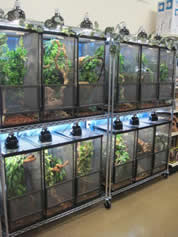Cages For Pet Chameleons: Setup and Upkeep of Chameleon Enclosures
Are you setting up for a new pet chameleon? Are there still some questions about how to set up their habitat? If so, then you should continue reading since it's extremely important to get a chameleon's habitat as close to natural as you possibly can. This article is going to focus on setting up your chameleon's habitat.
A Cage
Naturally, the first thing we're going to need is a cage to house the chameleon. There are a few  different choices here but what's important is that you ensure the habitat will have the best ventilation possible while also allowing for temperature control. different choices here but what's important is that you ensure the habitat will have the best ventilation possible while also allowing for temperature control.
Stagnant air and wrong temperatures are two of the most mistakes that beginners make when setting up a habitat for their first chameleon.
So the first major decision that you will face is the type of cage. This decision will depend on your budget and requirements. The three most popular choices are:
- Aluminum Screen Cages
- Reptariums
- Aquariums
The best choice here is a Reptarium since it's designed specifically for reptiles. They are very inexpensive, come in a variety of sizes, and the most well ventilated of the three options. The problem with glass aquariums is that they are difficult to ventilate.
Reptariums are also easy to take apart for cleaning purposes. It's lightweight and can be hand washed with little effort. You should line the bottom with a plastic tray so that it's easy to remove and clean. The makers of Reptarium sell a plastic tray that is designed for their habitats.
On the other hand, many first timers choose glass aquariums for their chameleon. If you do decide that you want to use glass, you will need to set up fans on each side so that you are providing constant ventilation. Please make sure you know what is involved in cleaning a chameleon's enclosure without harming the chameleon!
Finally, you will also need to purchase a thermometer and hygrometer to install inside of the habitat. Constant monitoring of both temperatures and humidity are necessary. Never try and guess.
You're looking at around $100 for all of these items so the investment is minimal. Therefore, go ahead and do it right. Otherwise, you're not going to get the best experience from owning a chameleon.
Decorating the Habitat
Now we get to do the fun stuff! It's time to install a few things into your chameleon's habitat that will make the little fellow happy. The best item to start with is plants.
Chameleon Safe Plants
Ficus trees, Umbrella trees, and pothos are the three most commonly used plants for chameleon cages. They can all be purchased from any plant nursery or garden shop. I recommend that you use either a pothos or umbrella tree since the ficus can be tricky at times. The number of plants you include in the habitat will depend on its size. You should also consider that you will have to clean it once a week so the more plants you have, the harder it will be to clean the habitat.
Arrange branches diagonally and attach artificial vines all around the cage to give your chameleon plenty of places to climb. Use black UV resistant zip ties to attach these artificial vines to the natural plants. Remember that if you went ahead and purchased a Reptarium then you should use the frame to your advantage by attaching vines to it as well.
NOTE: Ensure that no vines or branches are within 12 inches of the lamp. Chameleons will try and get as close to the light as possible and they will burn themselves in the process.
If you use branches from outside then you must disinfect them first. As strange as it might sound, the best way to disinfect a branch is to bake it at 350 degrees. You can also use bleach to disinfect larger branches but you must ensure that you thoroughly rinse it.
If you purchase a plant from the store then you must repot it before placing it into your chameleon's habitat. Pesticides are used on most of these plants so you do not want your chameleon exposed to these potentially deadly chemicals.
You will need to provide at least three branches for your chameleon to rest on. One should be around 12-14 inches from the basking lamp. Another should be a couple of inches from the bottom. Then you should place one between those two branches. This gives your chameleon three areas to regulate their temperature. For a list of suitable non-toxic plants, check out the "Chameleon Care Guide – Keeping & Breeding Healthy Chameleons Made Easy!"
Lighting
Let's wrap up this article by going over the lighting. Chameleons need two separate types of light: UVB and a basking lamp. The basking lamp keeps their temperature up while the UVB light will ensure they get enough D3.
Temperature Requirements
Basking Area: 85 – 90 Degrees
Daytime Ambient: 75 – 85 Degrees
Nighttime Ambient: 65 – 75 Degrees
Grab a copy of the "Chameleon Care Guide – Keeping & Breeding Healthy Chameleons Made Easy!", to learn all about:
- How to easily create a habitat for your chameleon that mirrors their natural environment and makes them feel right at home!
- 13 conditions that are required to have a healthy pet chameleon – ignore even one of these conditions and the health of your pet could suffer dramatically!
- How to "chameleon-proof" your home – here's what you need to know to ensure your house is perfectly safe for your "new addition"!
- Why chameleons require exactly 12 hours of light a day and failure to receive this amount could have tragic effects on their health!
- The number one cause of death of chameleons in captivity and how to avoid it!
- How to clean a chameleon's enclosure without harming the chameleon!
- How to set up a great watering system that will ensure your chameleon has the fresh water it needs on a daily basis!
- How to maintain the proper temperature and humidity for your chameleon – plus, what "substrate" is and how to set it up correctly!
- What toys and decorations to include in your chameleon's habitat – as well as how to clean the cage like a pro!
- And much, much more!

|